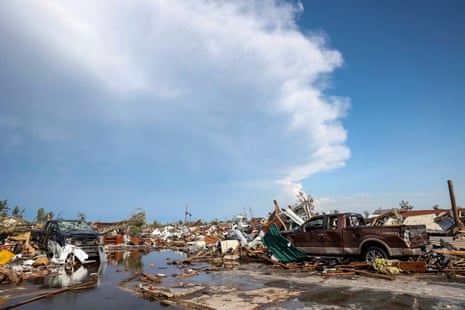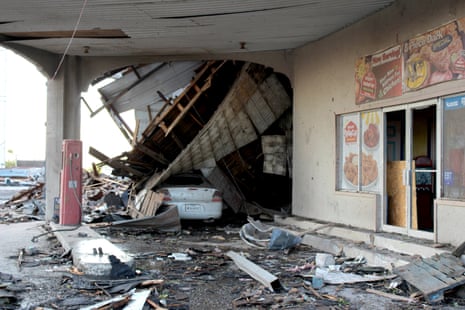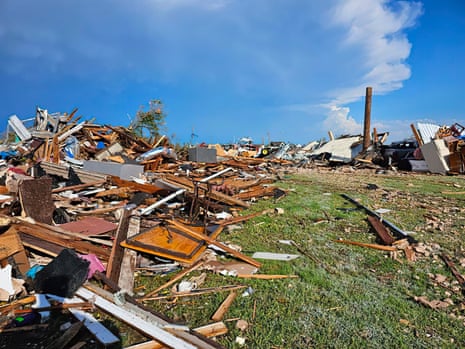Key events
Hail up to the size of baseballs has been reported in parts of central Arkansas, as thunderstorms continued to affect much of the south-eastern of the US.
The National Weather Service this afternoon issued a severe thunderstorm warning for the Arkansas vicinity southeastward into the Florida Panhandle and southwestern Georgia.
The biggest hail report came from Saline and Garland counties, where hail up to 2.75 inches or the size of a baseball was seen falling outside an auditorium in Hot Springs Village, local media reported. Similarly sized hail has also been reported in Sheridan and parts of Grant County, it said.
Parts of northeast Arkansas have also reported flash flooding and quarter-sized hail, it said.
Devastating tornadoes – such as the one that devastated the Texas town of Perryton on Thursday night – are set to become more common across the US, according to a report.
Tornadoes have long posed a peril to a column of the central US known as “tornado alley”, spanning parts of Texas, Oklahoma, Kansas and Nebraska. That alley is widening and could stretch into the south-east of the US, the BBC reports.
Previous research has shown that over recent decades there has been a stagnation, or even slight drop, in the number of tornadoes in their traditional home range of the Great Plains, but an uptick in states further east, such as Tennessee, Mississippi, Alabama, Illinois and Indiana.
While the influence of climate change upon tornadoes is still being investigated by scientists, some researchers say there is evidence that storms could become more powerful as the world continues to heat up due to the burning of fossil fuels.
Still, the factors driving tornadoes are complex and the link to climate change is far less understood than it is for phenomena such as heatwaves, for which scientists are now able to pinpoint an exact global heating influence for individual events.
Satellite images by the National Oceanic and Atmospheric Administration captured the supercell thunderstorm that pawned the deadly tornado that ripped through Perryton, Texas, on Thursday evening.
At least three people were killed by the powerful tornado, with dozens more injured and hundreds of homes destroyed, according to local authorities.
The latest update by the National Weather Service warns of a slight risk of severe thunderstorms across portions of the mid-Atlantic region, central High Plains and from the Arkansas vicinity southeastward into the Florida Panhandle and southwestern Georgia.
Earlier we reported that the Texas power grid operator ERCOT said it expected power use to break records next week, as homes and businesses crank up their air conditioners amid record-breaking temperatures.
The US energy regulator said it has also taken measures to push operators of power transmission lines to address vulnerabilities to extreme weather conditions, Reuters has reported.
It comes as the regulator published early findings of an inquiry into the winter storm Elliott in December 2022, which found that cold weather caused unplanned electric generation supply losses exceeding 70,000 megawatts (MW).
Some local utilities in the south-east of the US were forced to cut off flows to some customers on 24 December last year, the findings showed.
Since 2011, the US has experienced at least seven major extreme weather events which stressed electric grid operations, the US Federal Energy Regulatory Commission (FERC) said.
There was a a “robust and growing” body of scientific evidence attributing increasing extreme weather events to climate change, indicating that this trend will persist, FERC staff said.

Oliver Milman
A week after a pall of wildfire smoke turned New York City’s skies into a shade of apocalyptic orange, leaders in the US government and east coast states are wrestling with how to keep residents safe from the significant health risks.
The incomprehension over the worst ever day for toxic wildfire smoke in recent US history, which obliterated safe clean air thresholds and forced people to don masks outdoors, was summed up by Eric Adams, New York’s mayor, who admitted that the city was not primed for the sort of event more usually seen in California.
Experts have warned that cities like New York need the sort of wildfire smoke hazard plans that cities in California and elsewhere have adopted. In California and elsewhere, there are plans offering advisories to wear masks above certain levels of pollution, trigger interventions to help vulnerable people such as the elderly, and issue warnings to the public to stay indoors on smoky days.
Some have called for more fundamental reforms of bedrock clean air laws that were designed years before it was apparent that global heating is causing more frequent and larger wildfires, sending plumes of smoke dangerous to cardiovascular and respiratory health thousands of miles away. The smoke from wildfires in Canada that shrouded New York, Washington DC and other US cities eventually unfurled as far as Norway.
Here are some of the latest images from the newswires showing the devastation to the Texas town of Perryton, after a tornado ripped through the town on Thursday evening killing at least three people and injuring dozens more.



Extreme rainfall and heat hit China amid Asian heatwave
Many people in China have also experienced a variety of weather extremes in recent days, with parts of southern and eastern China seeing prolonged periods of torrential rainfall, as the summer rains known as “dragon boat water” got off to a remarkable start.
The city of Yulin in the Guangxi region experienced 35 hours of non-stop rain on 8-9 June, while the nearby city of Beihai was flooded after 614.7mm of rainfall over 24 hours in the same period. This is approximately a third of the city’s average yearly precipitation, and a June record for the Guangxi region. It is in stark contrast to May, when Guangxi experienced its lowest rainfall in 60 years.
Meanwhile, parts of eastern China were hit by severe thunderstorms over the weekend. Gale-force winds and hail caused damage to many areas, with three people killed in the city of Wuhu in the Anhui province when a shipyard crane was toppled.
Simultaneously, many parts of China have been experiencing high temperatures. Much of northern China has seen temperatures in the high 30s Celsius in recent days, with parts of Xinjiang province rising above 40C over the weekend. Energy companies are appealing to citizens to reduce energy use in some cities, as the increased use of air conditioning placed strain on the electricity grid.
These high temperatures come as part of the ongoing Asian heatwave, which continues to break records across the continent. There have been several all-time highs in Siberia in June, and monthly records for Hong Kong and Vietnam, while Japan declared the period from March to May its warmest on record.
Read the Guardian’s full analysis here:
With temperatures in Texas forecast to hit triple digits over the Juneteenth weekend, the state’s power grid operator said it expected power use to break records next week as homes and businesses crank up their air conditioners.
The Electric Reliability Council of Texas (ERCOT), which operates the grid for more than 26 million customers representing about 90% of the state’s power load, projected power use would rise to highs of 81,019 MW on Tuesday and 82,295 MW on Wednesday.
Extreme weather is a reminder of the deadly 2021 blackout that left millions of Texans without power, water and heat for days. ERCOT has said it has enough resources to meet next’ week’s power demand, Reuters reported.
Multiple tornado warnings have been issued in New Jersey on Friday afternoon.

